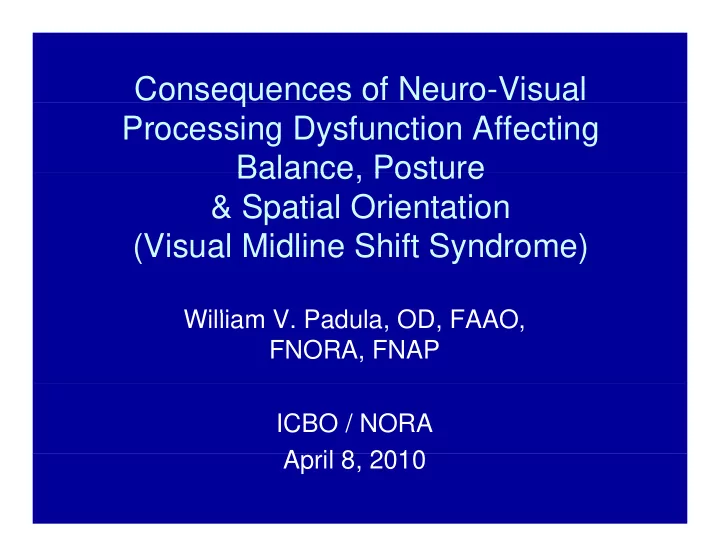

Consequences of Neuro-Visual q Processing Dysfunction Affecting Balance Posture Balance, Posture & Spatial Orientation (Visual Midline Shift Syndrome) (Visual Midline Shift Syndrome) William V. Padula, OD, FAAO, Willi V P d l OD FAAO FNORA, FNAP ICBO / NORA A April 8, 2010 il 8 2010
of Vision Rehabilitation 2 i Padula Institute R h bili Vi i
Neuro - Visual Processing Neuro Visual Processing Dysfunction Affects • Posture • Balance Balance • Spatial orientation • Attention and concentration Att ti d t ti • Binocularity
Balance Posture Movement Balance, Posture, Movement and Spatial Orientation • Affected by: Affected by: -mismatch between vision and sensorimotor information sensorimotor information
Neuro-Visual Processing: A Model for Visual Rehabilitation
Need for Neuro Optometric Need for Neuro Optometric Rehabilitation • Visual Processing Problems • Binocular Function Problems • Balance/Posture • Cognitive Rehabilitation through Lens/Prism/Sect e s/ s /Sect • Hemianopsia 6 6
Neuro-Visual Processing Rehabilitation Rehabilitation • Applied principles of movement and A li d i i l f t d posture to understanding of vision processing i • Use of prescribed therapeutic lenses and prisms to affect posture and movement through visual processing
Ganglion Cells from Retina Magnocellular—shape and movement (rapid) Magnocellular shape and movement (rapid) Parvocelluular—detail information contained in shape (much slower) shape (much slower) Konicocellular 8
Retinal Cells Transverse Retinal Cells Transverse Through • Retino-geniculate cortico pathway—P R ti i l t ti th P and M cells • Retino-tectal pathway—M cells for spatial orientation prior to focalization (posture and balance) 9 9
Neurological Visual Pathway Neurological Visual Pathway to Superior Colliculus • Optic Tract via Superior Brachium O ti T t i S i B hi • Occipital Cortex via Optic Radiations (through Lateral Geniculate) • Spinotectal Tract (from Spinal Cord and p ( p Medulla) 10 10 10 10
Lateral Geniculate • Dorsal Ganglion – relay and distribution of visual information to portions of brain p other than occipital cortex • Ambient Vision – 20% peripheral fibers match and relay with axons delivered to match and relay with axons delivered to superior colliculus 11 11 11 11
Motion Perception • Retinal sensory (ambient vision) • Ganglion cells Ganglion cells • Lateral Geniculate • Thalamus Th l • Occipital cortex 12 12 12 12
Coordinated Movement Requires Interaction Between Requires Interaction Between • Sensory afferents from vision (ambient) • Somato-sensory S t • Vestibular 13 13 13 13
Information from Superior Colliculus (Ambient Vision) (Ambient Vision) • Integrates with head and body postural information flowing through g g - Vestibulo-spinal tract - Vestibulo-cerebellar tract Vestibulo cerebellar tract 14 14 14 14
Multi-Sensory Integration and Multi Sensory Integration and Conscious Perception • Projected into secondary and associational cortices of Frontal, , Parietal, and Temporal Lobes • Produces awareness of: Produces awareness of: - Dizziness - Vertigo V ti - Imbalance 15 15 15 15
Vi Visual Midline Shift l Midli Shift Syndrome Syndrome 16 16 16 16
Modifying Postural Adaptation Following a CVA Through Prismatic Shift of Visuo-Spatial s at c S t o suo Spat a Egocenter • W. Padula OD, C. Nelson PhD OTR, W. Padula MS, R. Benabib MS, T Yil T. Yilmaz MPH, MPH S. Krevisky MS • Brain Injury (2009) 23:6, 566-576
Lean or Ambulatory Drift • Is it neurological? g • Is it visual? • Is it both? (Eubank and Ool 2001) • Is it both? (Eubank and Ool, 2001) (Nelson and Benabib, 1993) 18 18 18 18
Postural Adaptation Following Postural Adaptation Following a CVA • Lean Toward the Hemiparetic Side L T d th H i ti Sid (uncompensated state) • Lean Away from the Hemiparetic Side y p (compensated state) 19 19 19 19
Postural Adaptation Following Postural Adaptation Following a CVA • Lean Toward the Hemiparetic Side p (uncompensated state) • Lean Away from the Hemiparetic Side (compensated state) (compensated state) 20 20 20 20
21 21 21 21
22 22 22 22
23 23 23 23
24 24 24 24
25 25 25 25
Case Studies (Videos)
VMSS Affects • Spatial orientation for p – Posture – Balance a a ce – Ambulation – Driving Driving – Spatial localization
Conclusion • Neuro-Optometric Rehabilitation is and Emerging Specialty • NeurOpto-Postural Therapy is a specialized N O t P t l Th i i li d approach within NOR • Following a Neurological Event the Majority • Following a Neurological Event the Majority will have Visual Dysfunction • Post Trauma Vision Syndrome and Visual y Midline Shift Syndrome • The Interdisciplinary Challenge 28 28 28 28
Neuro-Visual Processing Neuro Visual Processing Treatment Approaches • Lens • Prism -Yoked Prism Yoked Prism -Enhanced Field Prism • Sectoral Occlusion • Visual-Postural Therapy py 29 29 29 29
Padula Institute of Vision Rehabilitation Rehabilitation PO Box 1408 Guilford, CT. USA 06437 203-453-2222 Web: padulainstitute com Web: padulainstitute.com Email: wpadula@padulainstitute.com pad la@pad lainstit te com 30 30
Recommend
More recommend